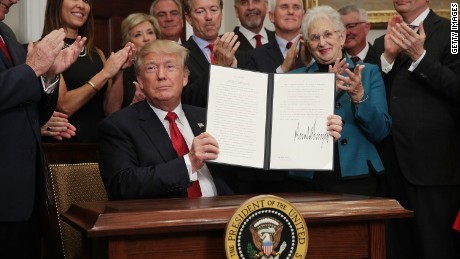President issues executive orders on drug pricing

Order #1: Requires some health centers to provide negotiated discounts on insulin and injectable epinephrine (EpiPens) to eligible patients. For patients to qualify for the discounts, they must be low income and either have high cost sharing for insulin or injectable epinephrine, have a high unmet deductible or no health insurance.
Order #2: Eliminates rebates given to pharmacy benefit managers (PBMs) who serve as “middlemen” between drug makers and pharmacies and help set drug prices. Drug makers offer these rebates to get their products covered by more health plans, and the savings are supposed to go back to patients—but that is not always the case. Without these rebates, the administration claims patients will see bigger discounts on their drug costs. The rebate ban will not apply if it raises premiums for patients, making it difficult to implement, since prices may go up to offset lost revenue.
Order #3: Allows the importation of drugs from Canada and allows manufacturers to import their products from other countries. Patients can apply for waivers to import drugs for personal use if it doesn’t impose a public safety risk, but the Food and Drug Administration (FDA) previously said it is difficult to determine the safety of imported products.
Order #4: Revives a previous plan from the administration to utilize an international pricing index. This would link the cost of Medicare Part B drugs given in a physician’s office of a hospital to what other countries pay. It is unclear which countries will be included in the index and what prices will ultimately look like.
“We’re going to hold that until August 24, hoping that the pharmaceutical companies will come up with something that will substantially reduce drug prices,” Trump said. “The clock starts right now.”
Drug manufacturers are not pleased with the order, citing concerns over COVID-19, price fixing, and decreased production and innovation.
It’s unclear what impact the orders will have in the near term, as they cannot be enacted immediately. The orders direct government agencies to begin the slow regulatory process to make changes within the existing system.
This is a developing story. We will provide updates as they occur.
Congress debating next COVID-19 relief bill

These proposals center around several issues:
- Stimulus payments
Both proposals call for a second round of stimulus payments of $1,200, but Democrats want to allow the payments for dependents, capping payments at $6,000 per family. Republicans want to limit payments to dependents (regardless of age) to $500 each.
- Unemployment benefits
The $600 unemployment enhancement benefit expires on July 31. Democrats are pushing for an extension of the benefit until December 31, while Republicans want to reduce the payment to $200 and extend through December 31.
- Small business loans
Republicans support extending the Paycheck Protection Program (the small business loan program established under the CARES Act) to businesses that have fewer than 300 employees and have lost at least 50% of revenue in the second quarter of this year. While Democrats didn’t directly address the program in their proposal, they support extending it if needed.
- Education funds
Both proposals allocate around $100 billion in funding to schools but differ on how the funds are spent. Democrats want $90 million for K-12 schools and the remaining $10 billion for colleges. Republicans want $70 million for K-12 schools and $30 billion for colleges, but a third of that money would be evenly distributed between all districts, while the remaining two thirds would go to districts reopening schools with in-person education.
- Liability protections
Republicans support protections for businesses, schools and health centers that prevent employees from taking legal action if they contract the virus, while Democrats want to create regulations requiring employers take steps to protect employees from the virus.
- State and local funds
Republicans offer no additional funding for states or local governments, but Democrats include an additional $500 billion, with $375 billion going to local governments and $125 billion going to states.
As negotiations between the House and Senate take shape, these points will likely change, and other ideas may come forth. We will keep you informed as the proposals change.
Ask Congress to fund cancer research

In the COVID-19 relief proposal submitted by Republicans in the Senate, $10 million is allocated to the National Institutes of Health (NIH) to restart cancer research and clinical trials. Overall, the NIH would receive $15.5 billion in their proposal.
The House proposed a $1.37 trillion funding bill (H.R. 7617) for several agencies, including Health and Human Services (HHS).
While the House and Senate are focused on negotiating COVID relief packages, Congress will likely pass a continuing resolution to fund the government until after elections in the fall.
It is critical that we ask Congress to prioritize cancer research and clinical trials in 2021. Spread the word and take action here!


